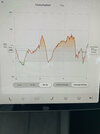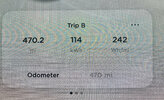I have a 2019 LR RWD, 4/19 build, the last of them built before they went away, 324XXX VIN.
I started running SMT after about 6 months of ownership and 6,642 miles. My NFP at that time showed 77.6. I bounced around a bit, 77.4, 77.5 but the last recording of 77.6 was at 7,871 miles almost a year after picking up the car. The Energy Buffer setting when new was 3.5. It dropped to 3.4 at 10,339 miles in Dec. 2020. In June 2021 at 12,100 miles it dropped to 3.3 and has stayed there since.
Today I'm at 13,900 miles and showing a NFP that has been bouncing around 72.9-73.3 for the past few months.
For the first year of the car's life it stayed at 50% SOC between trips. I have a Nissan Leaf I use as daily beater for errands and to go play golf. The Model 3 is the trip/weekend car. I would charge the car to whatever SOC I need to stay in the middle of the pack as much as possible. Lots of 60-40 or 60-30 SOC trips.
When I took the car on its first 1,500 mile road trip I could still stay between 70-30 SOC for most stops thanks to the Supercharger network.
I've charged to 90% maybe 3-4 times. I've never been lower than 15% and that was just to let the battery sample a low SOC. That brings up
this article I've been following the last 8 months. It argues the car needs to sample various SOC levels for 4-6 hours to properly calibrate the BMS.
I've usually let my car sit for a few hours when returning home, but started giving the car time to sit at a higher SOC for 4-6 hours before leaving on a trip giving the BMS time to sample.
My car is still showing 312-315 miles of rated range in SMT at 13,900 miles. Curious to see if battery degradation will level off or slow down now. I'm showing about 6% capacity loss and and about 3.7% range loss compared to 325 miles of rated range.
Not sure if I'm lucky with a "good" pack or how much I've helped myself with good battery care. My conservative approach is to stay between 70-30% SOC as much as possible and continue to store the car between 35-50% SOC. The EPA doc for the Model 3 battery calls for 15-50% SOC for long-term storage. I also take that to mean 15% is as low as I will try to go before recharging while on trips. But there will be times I may need to go to 100 or 0 to make a trip work and will charge or discharge as needed. But otherwise I'll ignore Tesla routing suggestions to go from 90-10 is I can insert another SC stop in between to stay between 70-30. I'm sure this will also be kinder to the battery when Supercharging.
Any thoughts Alan or Lastgas?
I’m sire your charging schedule has been nice for the pack.
There is a misconception fairly spread about staying in the middle of the SOC range.
Lithium batterys degrade less from time by being at a low SOC, the lower the better.
As long as you stay above the specified minimum voltage for the cell, lower is always better.
Tesla recommends charging when below 20%. This is most certain not for the health of the lithium pack, but it is to ensure that the battery dont go down so low in SOC that it stops charging the 12v lead battery. If tjis happens, we have two problems: where stuck and also lead batteries get damaged by low state of charge.
So, leaving the car at 5% will not hur the lithium battery pack but if the power drains we might be in trouble.
For calendar aging, low SOC is best and one smart thing would be to set the charging to commence so the charging is just done( with a margin not causing range anxiety) before needing to use the car.
The cyclic aging, in many cases this is less than the calendar aging, specially in the beginning of the battery life.
Cyclic aging is less with smaller cycles( DoD).
Also, cyclic aging is less when the SOC range is lower. This means 50 to 20% causes less wear than 70 to 40%. ( still 30% DoD in both cases).
The BMS calibration doesnt ad any real range. It ad miles on the battery meter but it wont put any extra kWh in the battery so the real range doesnt change. So one car with a good calibration where the Nominal full pack value is good showing 300 miles range will not go further than a car with a bad calibration, showing 270miles( but with a battery pack that is as good as in the first car). Whatevere we do, to know the ”true” degradation we need to do a full charge and drive one single drive until the car stops.
Compared to a really battery health minded charging scedule, I would say that the BMS calibration ad strain to the battery. Not by that much though, but in the light of the knowledge that a successful BMS calibration we dont gain any real range. We just increase a number on the screen and its only making us feel better, not the car.
There is a lot of research on lithium ion, and NCA in specific that show us that it will make a noticable difference to have the battery below about 57-60% true SOC ( which is about 54-57% on the Tesla battery meter) when the car is not in use, as the curve for calendar aging makes a jump for the worse above this number.
Just going below this, from, say 62% to 55% will cut the calendar aging in half.
There is also a thing that I’m not even sure if it is a good idea to write here, because it might cause battery anxiety.
Some of the battery research on Panasonic NCA cells implies that the worst calendar aging is happening with a SOC of about 75 to 85%. There is more than one research report that had that finding, I think at least I saw two of them and a couple of others that show traces of this when looking at them and knowing about the issue.
Tesla say “Up to 90% daily” and 90-100% for traveling.
I wont argue that, but I would say that it is not very good with 89% even if being on the right side by the Tesla norm. 70-90% most certain cause much more strain than some think.




